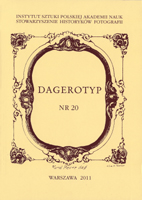Niemieckie fotografie lotnicze Warszawy z czasu II wojny światowej w Archiwum Narodowym w College Park (USA)
German World War II aerial photographs of Warsaw in College Park (USA)
Author(s): Zygmunt WalkowskiSubject(s): Photography
Published by: Instytut Sztuki Polskiej Akademii Nauk
Keywords: photography; German photography; vintage photography; history of photography; old photographic technique; aerial photography; Warszawa; Warsaw; College Park; World War II; Warsaw Uprising; ghetto
Summary/Abstract: After the end of World War II a huge consignment (weighing around 7 tonnes) of Luftwaffe photographic materials was taken from Germany to the United States of America, and is now housed at College Park near Washington (Figs. 103a-b). The author spent more than three months there (in 2003 and 2007) searching for aerial photographs of Warsaw. He looked at several tens of thousands of aerial photographs which formed only a small part of the collection. The oldest photographs dated from the turn of 1940/41, and the most recent dated from March 1945. // In order to acquaint the reader with this kind of materials, the start of the article presents and describes 13 aerial photographs (Figs. 61-62, 64, 67-76), most of which date from 1944. In the central part of the article, the author gives an account of the method he devised for identifying, analyzing and cataloguing aerial photographs. His method consists of making a mutual comparison and superimposing appropriately scaled and adapted aerial and satellite photographs on part of a map of Warsaw from dating from 1935 and a current map (Fig. 77-80). // The article ends with the author giving three examples of the use of aerial photographs in studies concerning the capital city’s pre-war development (almost entirely destroyed by the Germans in 1944) and the events which took place there during World War II, and, in particular, the Warsaw Uprising in August/September of 1944. The first example relates to the execution of a group of civilians; the condemned civilians were hanged on the façade of one of the tenement houses on ul. Leszno (then located within the ghetto; Fig. 83-89). Due to using this method (Fig. 86-88) it was possible to determine at exactly which tenement house the execution took place (Fig. 85) and from where the two photographs showing the scene were taken (Fig. 90). The second example shows the exact location of Józef Elsner’s (the composer and teacher of Fryderyk Chopin) farm and house in the Targówek district (Fig. 91-96) where, in the Chopin Year, in 2010 (the two-hundredth anniversary of his birth) a monument was erected (Fig. 97). The third example concerns the localization in the Ochota district (Fig. 100-102) of a little-known statue of Marshal Józef Piłsudski, which was located on land belonging to the Military Airport in Okęcie (Fig. 99). // The article shows the significance of Luftwaffe aerial photographs for studies on the iconography and history of Warsaw. Thanks to these photographs it has been possible to solve some mysteries pertaining to the past that seemed impossible to solve.
Journal: Dagerotyp
- Issue Year: 2011
- Issue No: 20
- Page Range: 105-154
- Page Count: 50
- Language: Polish
- Content File-PDF

